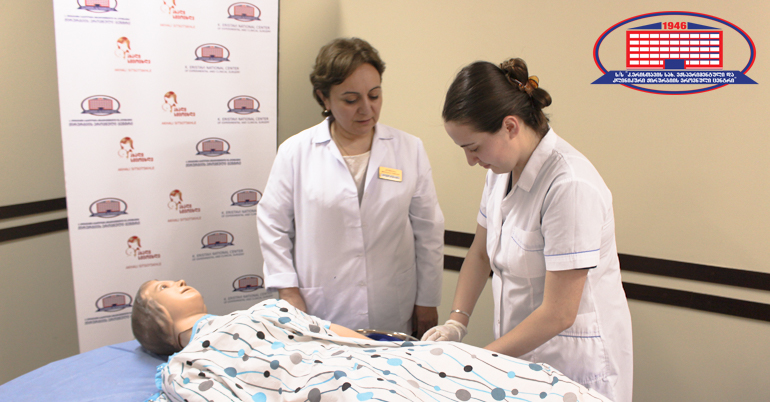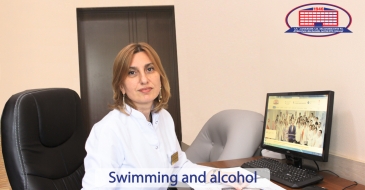
When every minute is precious!
Unfortunately, no one is safe from the accidents. For some readers this scene might be familiar, for example, when a family member, a friend or a completely unknown person faints. How does a person, who has no medical education, is not a medic and doesnt know first aid golden rules, act in that situation? Either calls an emergency service center or is so confused that isn't even able to contact emergency service center.
It’s even more dangerous to perform certain actions amid panic in order to help the victim. Such as shaking the victim to wake him/her up, pouring water in the mouth, forcefully opening the jaw and holding the tongue with hands and etc.
Of course, if you see the injured person, you have to call emergency in any case, but till the emergency brigade arrives, you may perform first aid procedures by yourself.
Remember, with properly performed first aid procedures, you might save a life, cease their pain and impede health condition worsening.
Lecture about first aid was held at National Center of Surgery. Within the cooperation with organization “career planning center”, clinic invited pupils on their last year of high school who plan on connecting their future with medicine.
National Center of Surgery’s chief paramedic Ketevan Kokiauri told pupils about the importance of first aid care, measures to be conducted and necessary skills.
In order to use theoretical knowledge in practice, Ms. Kokiauri presented a moulage to the guests. Moulage is an identical copy of adult human body. Therefore, audience could clearly witness how to perform first aid procedures.7
At the end of the lecture all pupils “helped and saved” moulage on their own.
We think, not only lecture guests, but every person should know about first aid assistance rules and this is why we present a few recommendations about which clinic’s chief paramedic spoke about during the lecture.
Please note that any example in the article is permissible only for helping adults ( National Center of Surgery serves adult patients and therefore the lecture is around this topic) and is categorically prohibited to repeat the same with children or infants
What actions do we take when we see an adult person unconscious :
- We check whether the environment is safe or not, for instance, is the incident caused by electric wiring?
- We get close and asses his/her general condition;
- By touching the shoulder, we try to determine if s/he can react. we check consciousness. We ask s/he identity. At this moment, it’s inadmissible to hit the person in the face in fear of damaging the jaw area.
- If there’s another person around, we ask a particular person from our surroundings to call the emergency . If we are alone with the victim, we call using "speaker" mode
- We start to push (compress) the chest area a bit left to the chest bone and at the crossover of papilla. Its necessary to compress 100-120 times a minute.
- It’s necessary to count out loud;
- After every 30 compression, we conduct artificial respiration if there’s a special cylinder around us, we use it. If not then, we cover person’s mouth with a handkerchief or other material and then blow the air. Afterwards, we conduct 30 compression. This manipulation has to be continuous. Don't stop performing till emergency brigade arrives.
- During compression, victim has to be laid down on a solid surface.
- We check carotid artery using only two fingers. Keep in mind that pulse is checked only with one had and on the opposite side. If you’d like to check the pulse using the right hand, you have to examine left carotid artery. If you’re left handed, then you check right carotid artery.
Keep in mind, its inadmissible to perform artificial respiration in case of car accidents, air disasters and falling from heights. In those cases, you call the emergency and do not touch the victim, because every movement might be the cause of spinal injury or various trauma complications.
What actions do we take when adult has food stuck in the throat?
Recognizing this scenario is very simple. Frightened victim, as soon as realizes that the food or substance is stuck and can not breathe, instantly stands up and holds the throat, can not speak and asks for help without using words.
In those cases we act accordingly (Heimlich maneuver):
- If there’s another person around,, we ask a particular person from our surroundings to call the emergency . If we are alone with the victim, we call using “speaker" mode
- The victim must be bent forward.
- Put your arm around the victim from the back and make a fist above the navel.
- Move your fist from bottom to top direction several times. To put it simply, push your first to the body and move it towards the chest.
- You don’t touch the abdomen, if the victim is pregnant has a pot-belly or is obese. You perform manipulation above the abdomen.
- Its allowed to hit shoulder -blade for exhalation purposes.
We’d like to remind readers that National Center of Surgery cares about the professional orientation of young people and for this purpose has been cooperating with the organization "Career Planning Center" already for a year.
This organization helps young people to choose a profession and achieve success. On 31 May, the awarding ceremony organized by the Career Planning Center took place. The evening was held for the leader-representatives of the fields involved in the Social Responsibility Program, which helps young people to correctly choose profession, adjust to the professional role and achieve success. For its contribution to future generation’s development, National Center of Surgery was awarded a honorary prize.
National Center of Surgery address: Tbilisi, Dighomi, Chachava N5.
You may contact National Center of Surgery’s call center at 577 119 119 or 2 02 25 25.
Wish you health!












